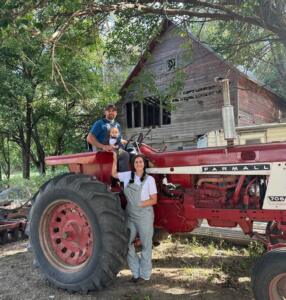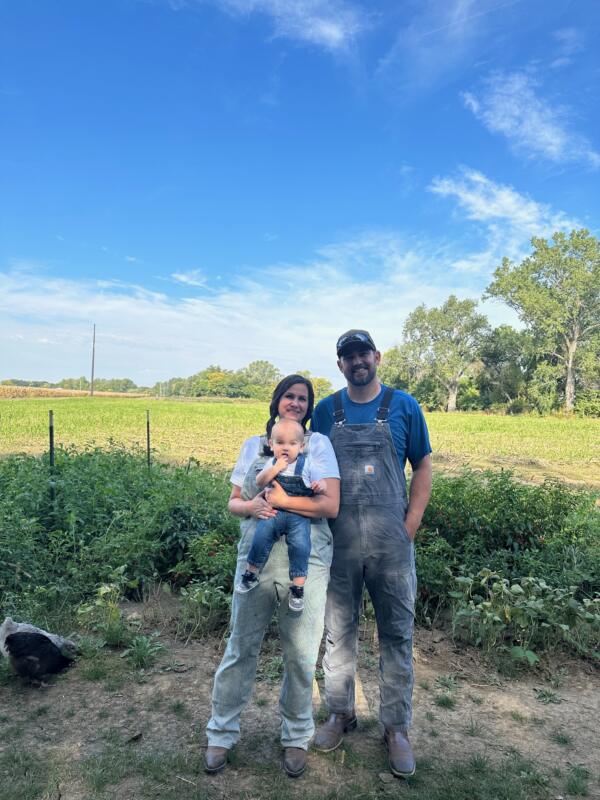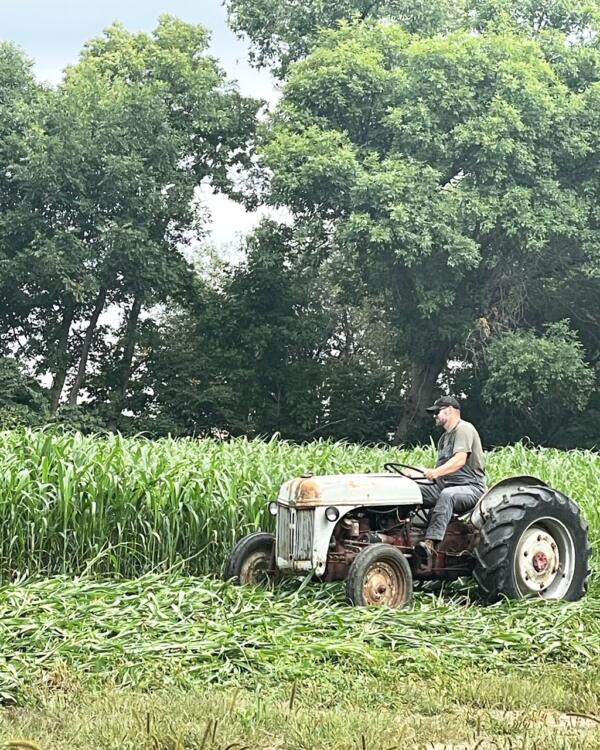Farmer-Led Trials Program Spotlight: Colby Farms
Written by Jose Perez, OFRF’s Research & Education Engagement Coordinator
Tim and Becky Colby own Colby Farms, a 14-acre farm in Papillion, Nebraska, where they produce vegetables, fruits, and some livestock products for their community. As beginner and veteran farmers, they are in their second year of transitioning a historically conventional farm to organic production. Having previously farmed in Arizona for three years, they came back to Nebraska to tend the land where Becky’s grandfather once farmed.
Tim and Becky have exciting plans for their farm. They hope, in time, to create a farm-to-school program, offer value-added food classes, and build a commercial kitchen. They hope to establish a fruit orchard with apples, peaches, and other stone fruits to offer u-pick, as well as raise chickens, goats, bees, and perhaps cows.

Dealing with soil compaction
The farm is located in a floodplain with clay-heavy soil vulnerable to compaction. Decades of conventional corn and soybean rotations have contributed to this problem. Tim and Becky knew from the beginning that they needed to improve soil structure to produce quality crops. A USDA representative also noticed soil compaction and recommended using deep taproot cover crops to address this challenge.
In their first year at their Nebraska farm, they planted a sorghum sudangrass cover crop, which resulted in a lot of organic matter being produced. However, they quickly noticed that the cover crop roots had failed to penetrate the soil beyond the hardpan.
Tim and Becky had a lot of questions to address regarding the use of cover crops to reduce soil compaction: What cover crop species should they use? How many cover crop cycles are needed? And, would there be any potential weed or pest concerns? Weed pressure is very high due to continuous use of the same crop rotation in the land for over 30 years. Sorghum sudan appeared to provide very good weed suppression but only after mowing three times. On the other hand, they are concerned about possible infestations of Japanese beetles, which have occurred in the past on soybeans. How would the cover crop respond to such an infestation? This is where their interest in OFRF’s Farmer Led Trials (FLT) Program came in.

Q: What motivated you to apply for the FLT program?
“Being part of the FLT program was a no-brainer for us on our farm. The land on our farm is in desperate need of rejuvenation and planting cover crops is the obvious solution. By partnering with OFRF, not only do we get some funding but we get to create a project that will help us determine the very best cover crops to solve some of our soil health issues. We get expert advice and feedback through all stages of the project from planning, implementing, data collection, and interpreting results. Then, at the end, not only does our Farm get answers to legitimate questions that will improve our soil, but we get to share this data with others that might be asking the same question. FLT’s are a win-win-win scenario for the farmer, the research group, and future farmers that will be able to learn from the data.” – Tim Colby

Farm trial plan
OFRF staff is currently working with Tim and Becky to figure out the best way to establish a cover crop comparison trial that can point towards the best cover crop options for reducing soil compaction at the farm. Using a 2-acre area, preliminary plans are to plant a mix of peas, oats, and vetch during spring and make the comparison for the fall season using daikon radish, tillage radish, rye, and canola cover crops. Preliminary measures include soil compaction, weed suppression, and soil nutrient levels through lab analysis.
Tim and Becky know that dealing with soil compaction goes beyond just planting deep-rooted cover crops. They have plans to use reduced tillage practices, and create permanent beds and living walkways in order to minimize soil compaction. All these measures will contribute to a healthier soil structure. At OFRF, we are excited to be a part of the Colby’s learning journey, and hope that their work will inspire more farmers to conduct research trials on their farms.
Research Results
The Colby’s conducted a farm trial to assess the effectiveness of various cover crops in reducing soil compaction. They tested four cover crop types: rye, canola (rapeseed), ‘Groundbreaker’ Daikon radish, and ‘Jackhammer’ radish against a control of mowed peas, oats, and vetch, and measured differences in soil penetration from fall to spring.
Key Findings:
- Cover crop species had no statistically significant impact on soil penetration depth, possibly indicating that having the soil covered with a crop is more important than the actual cover crop selected.
- While the data did not reflect differences in soil penetrability among cover crop treatments, the Colbys observed soil structure improvements. Notably, daikon radish and rye treatments were the most weed suppressive, and both daikon radish varieties contributed to greater visual improvements to the soil structure and penetrability.
Another added benefit of conducting the trial was that Tim became much more familiar with the land through frequent field walks, and he made different choices for subsequent crop placement based on his new knowledge.
For full details on the study’s methodology and results, read the final report.
This story is part of a series profiling farmers who are taking part in OFRF’s Farmer-Led Trials (FLT) Program. Farmers receive technical support from OFRF to address their challenges through structured on-farm trials. To learn more about OFRF’s Farmer-Led Trials Program, visit our website page at https://ofrf.org/research/farmer-led-research-trials/



